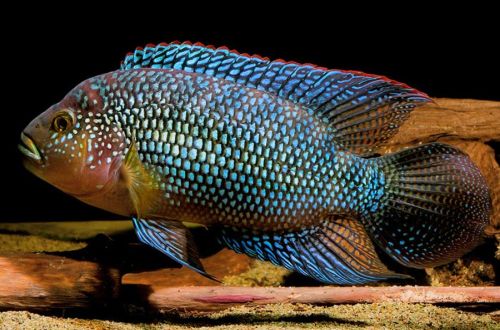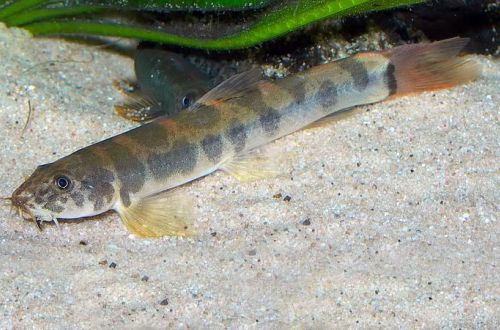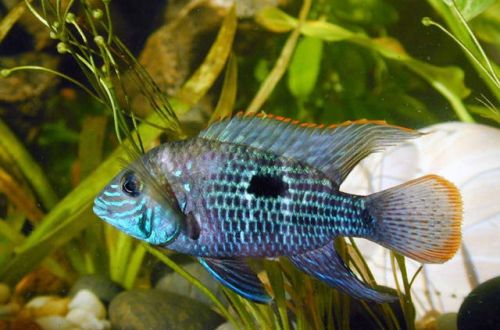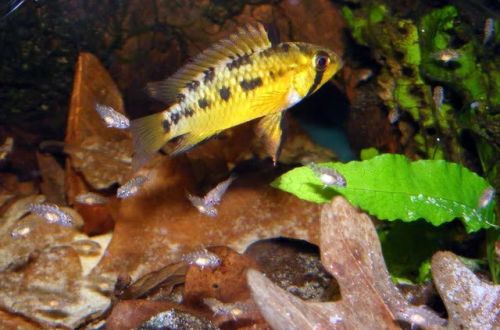
Macmaster’s apistogram
Macmaster’s Apistogramma or Red-tailed Dwarf Cichlid, scientific name Apistogramma macmasteri, belongs to the Cichlidae family. A beautiful, but rather temperamental fish for its size, especially during the mating season. It requires quite certain conditions for its content in terms of water composition, therefore, rather, it cannot be recommended to a novice aquarist.

Contents
Habitat
It comes from South America from the territory of modern Colombia. It occurs in a limited area of the upper Meta river basin, in particular in the Metica and Guayuriba rivers and their tributaries. The natural habitat consisted of tropical forests and extensive flooded, wetlands along the entire course of the rivers, but in recent decades the landscape has changed greatly due to the development of agriculture: tropical forests have been cut down, swamps have been drained for fields and pastures.
Brief information:
- The volume of the aquarium – from 40 liters.
- Temperature – 24-28°C
- Value pH — 5.0–7.0
- Water hardness – very soft (1-5 dGH)
- Substrate type – sandy
- Lighting – subdued
- Brackish water – no
- Water movement is weak
- The size of the fish is 4–5.5 cm.
- Nutrition – meat feed
- Temperament – peaceful, except during spawning periods
- Keeping in a group with one male and several females
Description
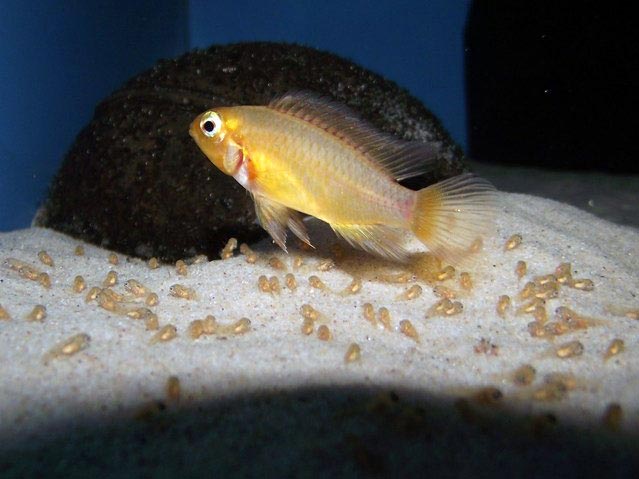
Adult fish reach a length of about 4–5 cm. Males are larger and have a brighter color compared to females. Depending on the selection form, yellow or red tones may predominate, the pattern remains unchanged and consists of dark parallel strokes and the same dark diagonal stripe passing through the eyes.
Food
It belongs to carnivorous species, in nature it feeds on small benthic invertebrates and crustaceans, insect larvae, etc. In a home aquarium, it is also desirable to serve live or frozen food (bloodworm, daphnia, brine shrimp). Alternatively, sinking foods (flakes, pellets) with a high protein content can be used.
Maintenance and care, arrangement of the aquarium
Mostly McMaster’s Apistogramma from commercial fish farms are on sale and there are almost never wild specimens, so the requirements for their maintenance are quite simple. The fish will thrive in an aquarium with a volume of 40 liters or more with a sandy substrate, plants (live or artificial) and a few shelters in the form of snags or other decorative objects. The lighting level is set to a muted one, plants floating on the surface can serve the same purpose.
Water conditions should have slightly acidic pH values with low carbonate hardness. Sometimes, to give the water a brown tint characteristic of its natural habitat, essences of tannins are used or leaves of trees with a high content of tannins are added, for example, European beech, oak, Indian almond. The leaves are pre-dried, then soaked until they begin to sink, and only then added to the aquarium. As it decomposes, tannins are released into the water, coloring it. Updated every few weeks.
Aquarium maintenance comes down to regular cleaning of the soil from organic waste and weekly replacement of part of the water (10–15% of the volume) with fresh water.
Behavior and Compatibility
Peaceful friendly fish, if kept in a group with one male and several females. If there are several males in a small aquarium, skirmishes for territory during the mating season are possible. Perfectly compatible with other calm species of similar size. It should not be kept together with other Apistograms to avoid hybridization.
Breeding / breeding
Under optimal conditions (suitable composition and temperature of the water, balanced nutrition), the probability of the appearance of fry is very high. During the spawning period, the female chooses a shelter and lays up to 120 eggs. Parental instincts do not end there, she remains to guard the masonry, and in the future she will protect the fry that will stay close to her. The male is also involved in the protection of offspring, but often he becomes overly aggressive and has to be temporarily relocated to a separate aquarium.
If several females are kept together, then all can give offspring at once. In this case, it should be provided that the number of shelters coincides with the number of females, and they are located in different parts of the aquarium.
Fish diseases
The main cause of most diseases is unsuitable living conditions and poor-quality food. If the first symptoms are detected, you should check the water parameters and the presence of high concentrations of hazardous substances (ammonia, nitrites, nitrates, etc.), if necessary, bring the indicators back to normal and only then proceed with treatment. Read more about symptoms and treatments in the Aquarium Fish Diseases section.



